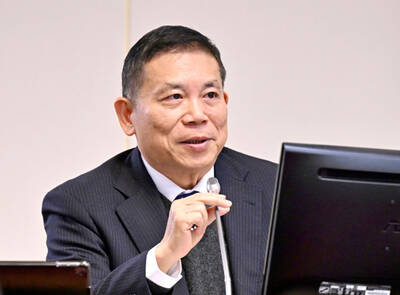India’s central bank kept interest rates on hold, while assuring markets of ample liquidity to manage the government’s near-record borrowing.
The Reserve Bank of India (RBI) is to sap some funds from banks by using the cash reserve ratio (CRR) — the amount of deposits that lenders must set aside as a reserve — as a tool and to use the money for more targeted market operations, Governor Shaktikanta Das said yesterday.
The bank’s Monetary Policy Committee separately decided to keep the repurchase rate unchanged at 4 percent.

Photo: Reuters
A previous CRR cut of 100 basis points to boost liquidity to fight the economic fallout of the COVID-19 pandemic is to be rolled back in two phases by May, Das said.
The cash is now to return to the central bank as reserves, allowing the RBI to, in turn, use it for open market operations and other liquidity measures, although Das did not specifically name any such programs.
“The RBI stands committed to ensure the availability of ample liquidity in the system and thereby foster congenial financial conditions for the recovery to gain traction,” Das said, stopping short of announcing specific measures.
Markets were disappointed by this lack of detail, especially regarding debt purchases by the RBI.
The yield on benchmark government bonds rose 5 basis points to 6.12 percent after climbing as high as 8 points.
The benchmark S&P BSE Sensex erased gains and was trading down 0.1 percent. The rupee strengthened 0.1 percent.
“The RBI is gradually withdrawing crisis time policies,” Nirmal Bang Equities Pvt economist Teresa John said. “Accommodative policy is here to stay and the RBI will act to prevent any sharp spike in yields.”
The central bank’s six-member panel also voted to retain its easy monetary policy stance for as long as is necessary to support growth, Das said.
The RBI, which last year lowered borrowing costs by 115 basis points, has been on pause since the middle of last year over inflation worries.
Although inflation is back in the RBI’s comfort range, higher government spending risks stoking price pressures and complicating the central bank’s efforts to resume policy easing.
Retail inflation eased to 4.6 percent in December last year, marking the first time in nine months that the headline rate returned within the RBI’s target band of 2 to 6 percent. That nudged the RBI to lower its inflation forecast — to 5.2 percent in the current quarter from 5.8 percent seen previously.
The RBI also upgraded its growth forecasts. It sees growth in the year starting April at 10.5 percent from an estimated 7.7 percent contraction in the current fiscal year.
That is slightly lower than the government’s 11 percent estimate and comes amid early signs of a recovery gaining momentum.
Indian Minister of Finance Nirmala Sitharaman on Monday unveiled a budget of almost US$500 billion to revive growth hurt by the COVID-19 pandemic.
The plan, which would rely on borrowing 12 trillion rupees (US$165 billion) to spend on healthcare and creating capital assets, would keep the budget deficit at a wider-than-expected 6.8 percent of GDP in fiscal year 2022.
“Monetary policy will continue to complement the expansionary fiscal policy through FY22, given the size of the borrowing program,” QuantEco Research founder Shubhada Rao said. “A balancing act may be needed in the second half of the financial year, as inflation is likely to creep up.”

UNCERTAINTY: Innolux activated a stringent supply chain management mechanism, as it did during the COVID-19 pandemic, to ensure optimal inventory levels for customers Flat-panel display makers AUO Corp (友達) and Innolux Corp (群創) yesterday said that about 12 to 20 percent of their display business is at risk of potential US tariffs and that they would relocate production or shipment destinations to mitigate the levies’ effects. US tariffs would have a direct impact of US$200 million on AUO’s revenue, company chairman Paul Peng (彭雙浪) told reporters on the sidelines of the Touch Taiwan trade show in Taipei yesterday. That would make up about 12 percent of the company’s overall revenue. To cope with the tariff uncertainty, AUO plans to allocate its production to manufacturing facilities in

Taiwan will prioritize the development of silicon photonics by taking advantage of its strength in the semiconductor industry to build another shield to protect the local economy, National Development Council (NDC) Minister Paul Liu (劉鏡清) said yesterday. Speaking at a meeting of the legislature’s Economics Committee, Liu said Taiwan already has the artificial intelligence (AI) industry as a shield, after the semiconductor industry, to safeguard the country, and is looking at new unique fields to build more economic shields. While Taiwan will further strengthen its existing shields, over the longer term, the country is determined to focus on such potential segments as

TAKING STOCK: A Taiwanese cookware firm in Vietnam urged customers to assess inventory or place orders early so shipments can reach the US while tariffs are paused Taiwanese businesses in Vietnam are exploring alternatives after the White House imposed a 46 percent import duty on Vietnamese goods, following US President Donald Trump’s announcement of “reciprocal” tariffs on the US’ trading partners. Lo Shih-liang (羅世良), chairman of Brico Industry Co (裕茂工業), a Taiwanese company that manufactures cast iron cookware and stove components in Vietnam, said that more than 40 percent of his business was tied to the US market, describing the constant US policy shifts as an emotional roller coaster. “I work during the day and stay up all night watching the news. I’ve been following US news until 3am

COLLABORATION: Given Taiwan’s key position in global supply chains, the US firm is discussing strategies with local partners and clients to deal with global uncertainties Advanced Micro Devices Inc (AMD) yesterday said it is meeting with local ecosystem partners, including Taiwan Semiconductor Manufacturing Co (TSMC, 台積電), to discuss strategies, including long-term manufacturing, to navigate uncertainties such as US tariffs, as Taiwan occupies an important position in global supply chains. AMD chief executive officer Lisa Su (蘇姿丰) told reporters that Taiwan is an important part of the chip designer’s ecosystem and she is discussing with partners and customers in Taiwan to forge strong collaborations on different areas during this critical period. AMD has just become the first artificial-intelligence (AI) server chip customer of TSMC to utilize its advanced